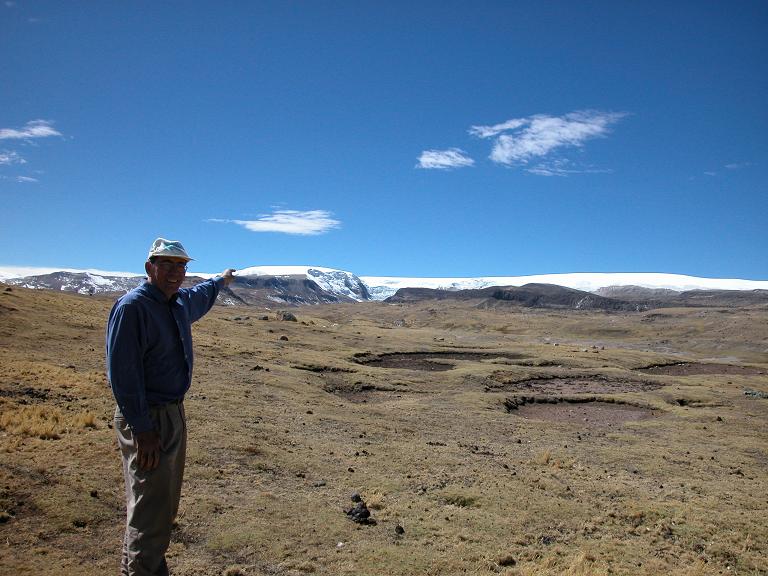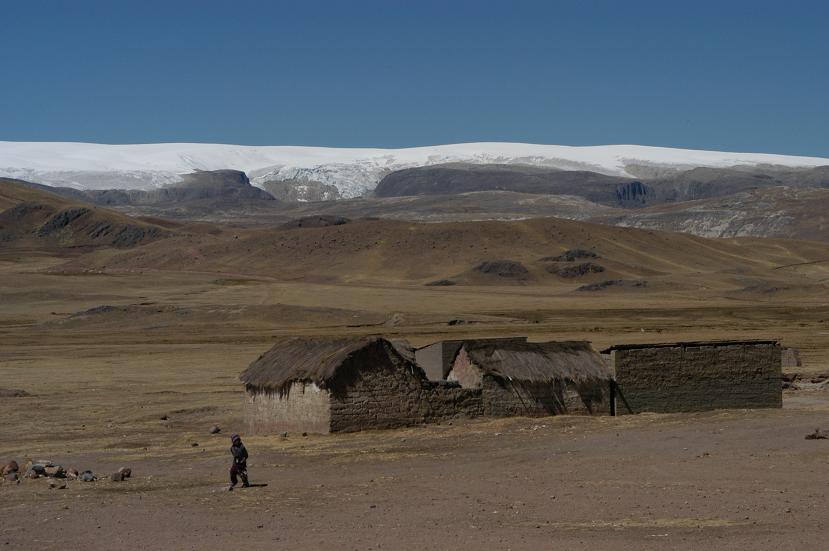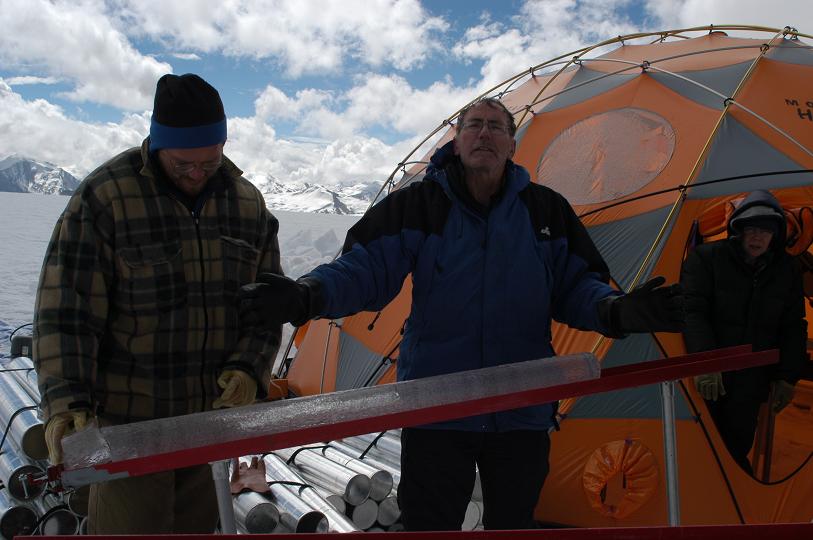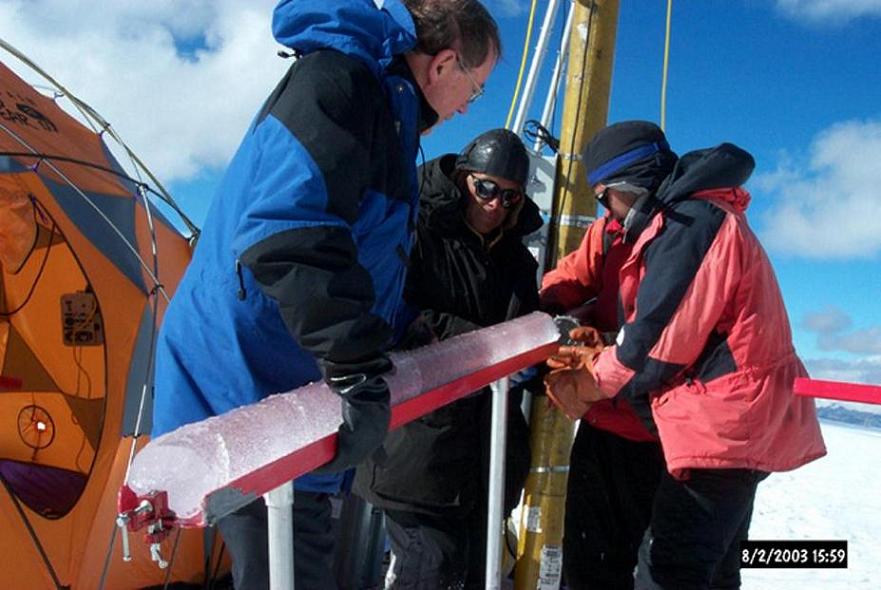Peru
Overview (1983)
The photograph at the beginning of our home page shows the annual layers as they have been preserved in the Quelccaya ice cap located in southern Peru (see map). Quelccaya (photograph) is located at 13o56'S; 70o50'W and has a summit elevation of 5670m a.s.l. Ice cores to bedrock were drilled in 1983 using the first solar-powered drill ( photograph). The cores were dated precisely (± 2 years at A.D. 1500) using a combination of seasonally varying dust concentrations and  18O, visible dust layers deposited each year during the dry season, and identification of ash from the A.D. 1600 eruption of Huaynaputina. Numerous paleoenvironmental records for this remote region have been extracted from these cores as reflected in the selected references below. Data and a slide set are available from the World Data Center - A for Paleoclimatology.
18O, visible dust layers deposited each year during the dry season, and identification of ash from the A.D. 1600 eruption of Huaynaputina. Numerous paleoenvironmental records for this remote region have been extracted from these cores as reflected in the selected references below. Data and a slide set are available from the World Data Center - A for Paleoclimatology.
Recently the Quelccaya ice cap has experienced an accelerating rate of retreat as the snowline has risen in response to a marked warming. The  18O record from a core drilled at the summit in 1976 is compared with that from one drilled in 1991 and reveals that the isotopic seasonal signal is no longer preserved and that the isotopic average is enriched by 2o/oo (figure). Terrestrial photography of the Qori Kalis outlet glacier (photograph), the largest on Quelccaya, has allowed Brecher and Thompson (1993) to document its accelerating rate of retreat (figure). A new project to extend the mapping of Qori Kalis to the entire Quelccaya ice cap using satellite derived data is underway as part of Neil Mackinnon's Master's Thesis.
18O record from a core drilled at the summit in 1976 is compared with that from one drilled in 1991 and reveals that the isotopic seasonal signal is no longer preserved and that the isotopic average is enriched by 2o/oo (figure). Terrestrial photography of the Qori Kalis outlet glacier (photograph), the largest on Quelccaya, has allowed Brecher and Thompson (1993) to document its accelerating rate of retreat (figure). A new project to extend the mapping of Qori Kalis to the entire Quelccaya ice cap using satellite derived data is underway as part of Neil Mackinnon's Master's Thesis.



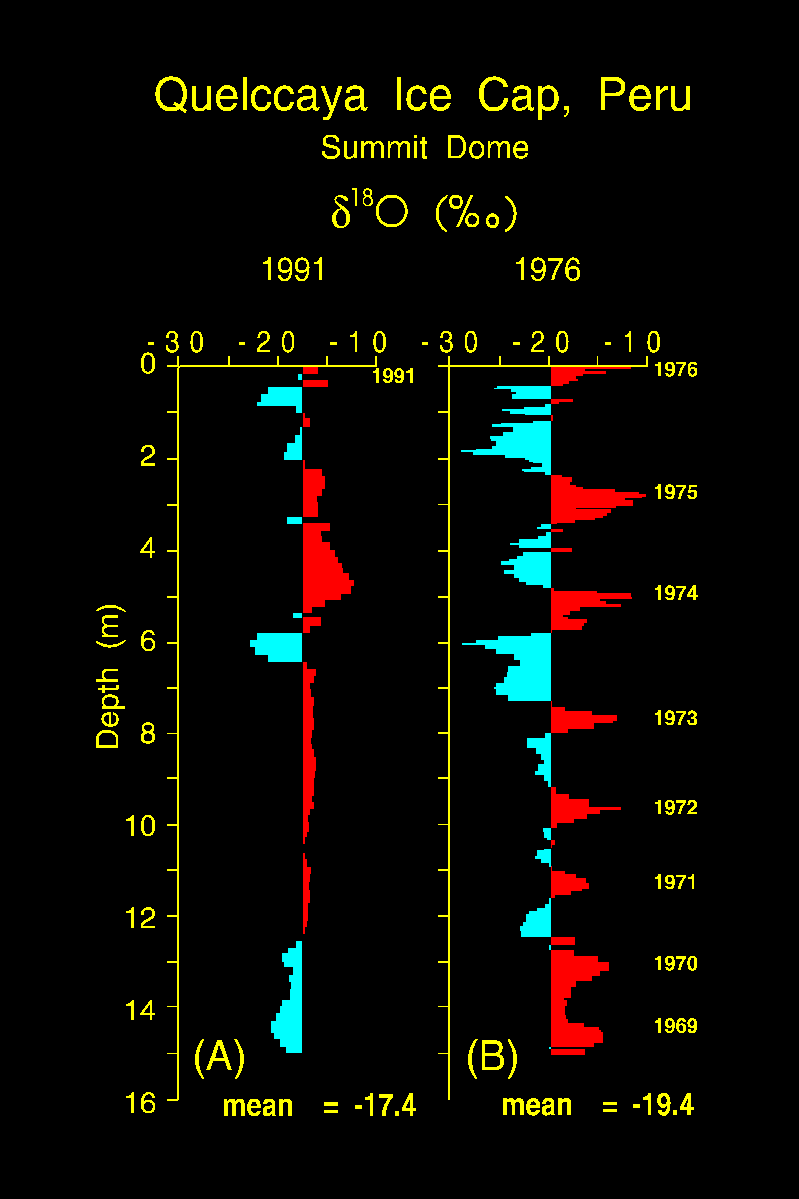
Overview (2003)
In July 2003 the OSU team returned to the Quelccaya ice cap in the southern Andes of Peru to drill a new set of ice cores to bedrock. As it was impossible to return the ice cores collected in 1983 to the Ohio State freezers, they were cut into small samples that were melted and bottled in the field. Therefore, the chemical and insoluble dust analyses were compromised. The newly collected cores will allow the dating of the cores by counting visible dust layers to be complemented by the seasonal variations in insoluble dust, δ18O, and soluble chemical species (major anions and cations). On September 10, 2003 the ice cores from Quelccaya and Coropuna were returned to the freezer facility at The Ohio State University's Byrd Polar Research Center (see photos) where they will be analyzed over the next year. This project was funded by the National Science Foundation's Earth System History Program in the Atmospheric Sciences Division. A brochure describing the Quelccaya-Coropuna Project is available below:
Three cores were collected on Quelccaya:
- Core 1 was drilled to bedrock (168.68 meters) on the Summit Dome (elevation: 5670 m asl)
- Core 2 was drilled to 29.74 meters on the North Dome
- Core 3 was drilled to bedrock (128.57 meters) on the North Dome
Selected publications:
Thompson, L.G., E. Mosley-Thompson, P. Grootes, and M. Pourchet. 1984. Tropical glaciers: potential for paleoclimatic reconstruction. Journal of Geophysical Research, 89 (D3), 4638-4646.
Thompson, L.G., E. Mosley-Thompson and Benjamin Morales Arnao. 1984. Major El Niño/Southern Oscillation events recorded in stratigraphy of the tropical Quelccaya Ice Cap. Science, 226 (4670), 50-52.
Thompson, L. G., E. Mosley-Thompson, J. F. Bolzan and B. R. Koci. 1985. A 1500 year record of tropical precipitation recorded in ice cores from the Quelccaya Ice Cap, Peru. Science, 229(4717), 971-973.
Thompson, L.G. and E. Mosley-Thompson. 1987. Evidence of abrupt climatic change during the last 1,500 years recorded in ice cores from the tropical Quelccaya ice cap, Peru. Abrupt Climatic Change - Evidence and Implications, NATO/NSF Workshop volume. D. Reidel Publishing Co., 99-110.
Shimada, I., C.B. Schaaf, L.G. Thompson and E. Mosley-Thompson. 1991. Cultural impacts of severe droughts in the prehistoric Andes: Application of a 1,500-year ice core precipitation record. World Archaeology: Archaeology and Arid Environment, 22(3), 247-270.
Brecher, H.H. and Thompson, L.G. 1993. Measurement of the retreat of Qori Kalis in the tropical Andes of Peru by Terrestrial Photogrammertry. Photogrammetric Engineering and Remote Sensing, 59(6), 1017-1022.
Thompson, L.G., M.E. Davis and E. Mosley-Thompson. 1994. Glacial records of global climate: A 1500-year tropical ice core record of climate. Human Ecology, 22(1), 83-95.
